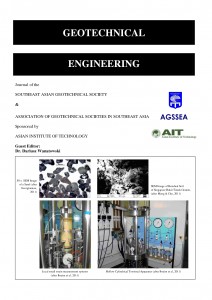Effect of High Confining Pressure on the Behaviour of Fibre Reinforced Sand
Main Article Content
Abstract
Several techniques of soil stabilisation and soil reinforcement are available for improving properties of geotechnical materials. However, the addition of fibre into soils has its unique potential. This is because friction between fibres and soil particles increases bonding between the particles. As a result, the stress-strain behaviour and failure characteristics of both cemented and uncemented soils reinforced with fibres can be improved. In this paper, the influence of fibre and cement on the behaviour of sand in a wide range of confining pressures is studied. Drained triaxial compression tests carried out on uncemented and artificially cemented Portaway sand with 0.5% randomly distributed discrete polypropylene fibres are presented. The experimental results show that stress-strain behaviour and strength characteristics of Portaway sand improve with addition of fibres. However, the effect of fibre reinforcement is more significant at lower confining pressures. At high confining pressures, the contribution of fibres is suppressed and the effect of high confinement becomes dominant.
Article Details

This work is licensed under a Creative Commons Attribution-NonCommercial-NoDerivatives 4.0 International License.
Copyright © 2019 Association of Geotechnical Societies in Southeast Asia (AGSSEA) - Southeast Asian Geotechnical Society (SEAGS).


